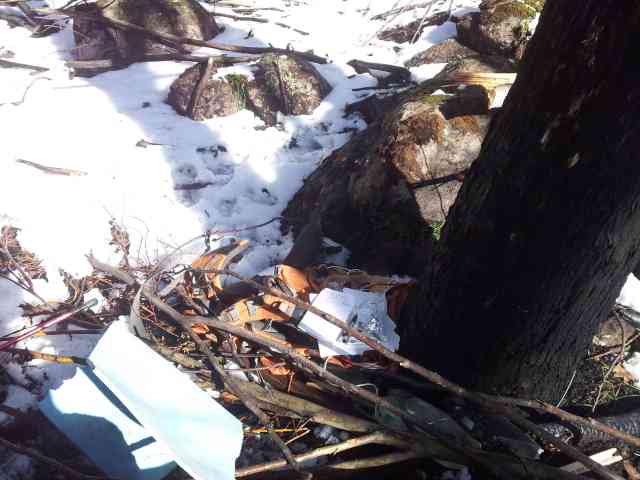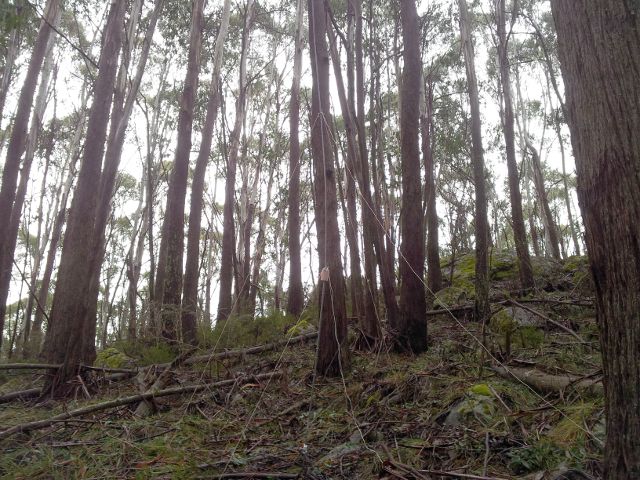Hi all,
On the 10th of August, I headed out on a SOTA trip to attempt to clock up some decent points with the winter bonus. This trip was a repeat of a trip last year, but a year’s experience and improved gear makes a difference. I’ll discuss some of the differences towards the end of the post.
Mt Bullfight VK3/VN-002
First up was Mt Bullfight. I left the car in the same position as I did on the last trip, at the junction of Snobs Creek Rd, Coy Rd and Conn Gap Rd. Heading up the Bullfight track to the west was easy going, and the plan was to take the same route to the summit, or at least into the activation zone as last year. There was a lot more snow this year, with about 40cm on the ground at the operating location. The first snow was seen at about 1100m on the way up. There is little point trying to take the track up with this amount of snow. I was quite glad I brought the foam mat to sit on during the activation.
I ended up activating about 100m or so from the summit, about 15m vertical down from the summit height.
The sun was starting to come out, so even though there was more snow, conditions were nicer than last year.
Pyramid Hill VK3/VN-005
Unlike last year, I decided to head back to the car and drive up to the No 5 track and Royston Range Track junction. The road is in good condition for 2wds. This allowed me to skip some off track walking. This certainly saved some time, and it was only a shorter 140m vertical climb up to the top. There was still some snow around, patchy in places, but 10cm continuous ground coverage in others.
Conditions were ok, there was one or two showers in the area. Sounds a lot better than stories of people being blown off the hill here!
Bill Head VK3/VN-004
Given that there was some snow on Pyramid Hill, there would certainly be snow on Bill Head. I decided to try Conn Gap Rd from the northern end, rather than the southern end as I did last year. The road is a little rough, but quite passable in a 2wd up to Conn Gap. With snow melt, it was very wet, so if I can get a Prius up here at this time of year, I should be able to get it up here at just about any time. I was not prepared to drive down the hill on the other side of Conn Gap, because it’s ok to see how far you can go when going up a hill on the way in, because it is always easier to go down than up.
From Conn Gap, I walked along Conn Gap Rd to point 067606 and then proceeded SW to the ridge. Going up to the ridge was a little slow with some of the dead timber from the regrowth from the Black Saturday fires in 2009. Along the ridge top itself it was easy going up to the summit in about 15cm snow.
It was nicer operating in the light, rather than in the dark last year. In July last year, SOTA was not well known in Australia, so it was a tough hall getting the four contacts – with two ZL’s and one VK6 making up the four. This time, it was the usual pile on 40m, so no problems in activating.
As it turned out, I have finally used the walking pole as part of the antenna. I wedged it behind a rock and tied a rope with feedpoint of the end fed on it.
Bill Head looks nice under the snow.
Wombat Spur VK3/VN-014
With Bill Head done, there was still plenty of time to go and get the bonus summit for the day. Wombat Spur is in the Eildon National Park. Access is via Jerusalem Creek. The road is a good quality 2wd track until the crossing of Jerusalem Creek. From there, there is a sign saying 4wd only, but the road is still quite good. I was able to drive the car all the way up Taylors Creek Track to a locked gate at point 115720. From here, when accessible out of the winter closure period, the track is definitely 4wd only. For me, it was still only a short walk up to the summit. Conditions were pleasant up here, and as it was lower down, dry due to no snow.
Some of the activations today had quite high QSO totals, but this activation came in at 36, which is a record for a non-contest, short period activation. Still, the pile was reasonably easy to manage. This does rely on chasers not calling out of turn. For activators out there, it remains a good thing to call for summit to summits every so often.
I was able to pack up and get down on to the sealed road before nightfall. All in all, a good day.
Review vs last year
- One of the biggest differences this year is the greater awareness of SOTA. Many more people are specifically chasing SOTA, while in July 2012, it was still quite patchy. A year makes a big difference.
- End fed vs an inefficient vertical: I still use my vertical on some activations, but having the ugly balun and the ATU on the feedpoint makes a big difference. The efficient vertical is still down on a (sort of) horizontal antenna for close in contacts, but perhaps an s point or 2. Last year I was well down. Getting the antenna efficient is quite important when operating QRP.
- Having an antenna that can be quickly erected is important, both for put up and take down time. A year ago, I was not yet using squid poles. I was guying up an aluminium pole that needed guying to stay up. Even when using the vertical, I am using a squid pole based antenna these days. The end fed is very fast to put up and take down, less than 10min for each, vs 30 to 45 minutes for my setup twelve months ago. Even now, the vertical does take longer because the radials still have to be put out. My vertical arrangement now is about 20 minutes setup and 15 minutes takedown.
So with all of that, I was able to activate four summits easily in daylight, vs last year where I could spend 2 hours on summit, calling CQ, CQ, CQ and hearing just noise most of the time.
It is great to look back at these activations and see not only 36 contacts in little more than half an hour, but there is lots of fun getting up and back – both on foot and in the car.
Regards, Wayne VK3WAM








You must be logged in to post a comment.